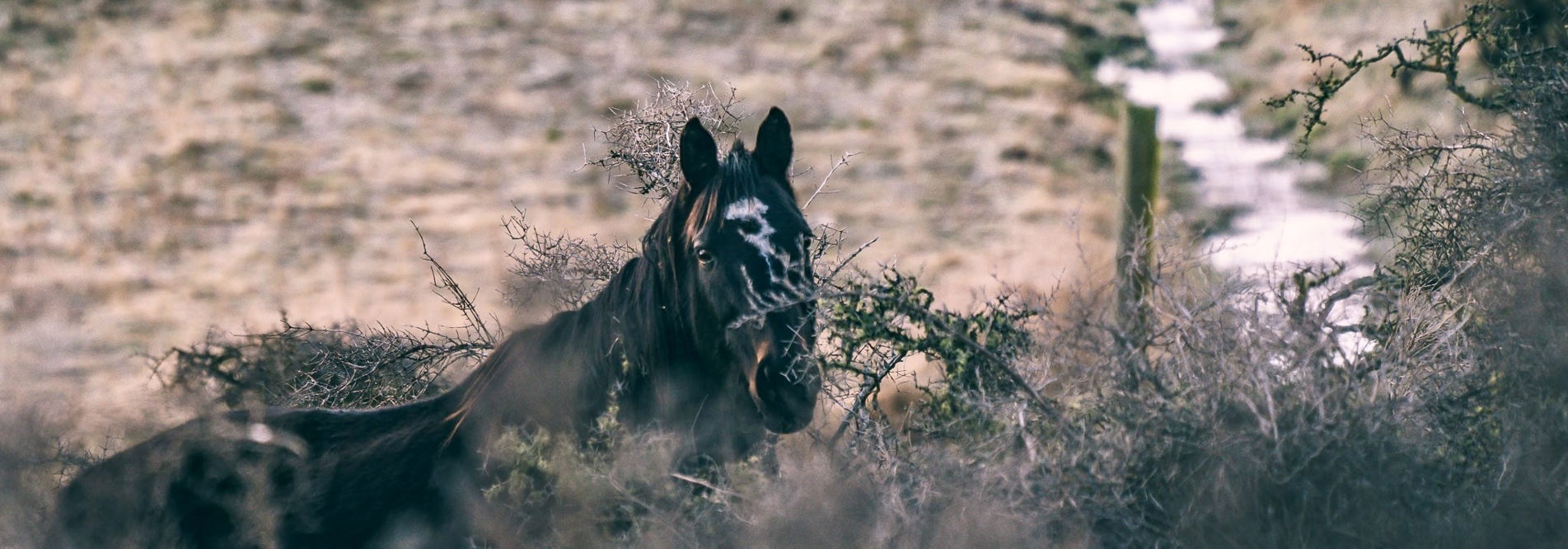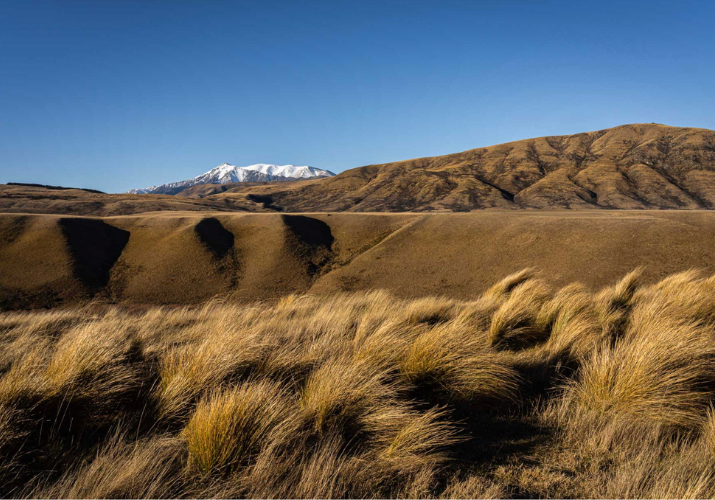
The Flora & Fauna of Canterbury High Country
There are a number of indigenous and local shrubs, trees and tussocks that inhabit Flockhill. Many of species can be found nowhere else on earth but in environments like ours, gifted the ability able to survive, and even thrive in our unique geography and climate.
Flockhill also plays host to some rare and threatened bird species; species which are drawn to our unique environment for its vegetation, topography and food sources. Many of these species are at risk due to predators or loss of habitat across New Zealand, so we are fortunate to have them in our presence.
Tussock and sedge
Chionochloa (tussock) is a hardy grass species with the ability to survive for hundreds of years in a range of soil conditions, including the exposed environment and high altitudes of the New Zealand high country. The soils of Flock Hill Station support two specific endemic tussock species; red tussock, with its rustic tones; and snow tussock, in shimmering greenish-gold. Both these tussocks play important roles, helping to maintain life and biodiversity on the high country property. While red tussock provides an important barrier for wetlands and helps to reestablish wildlife habitat, snow tussock collects and retains water and provides habitat for a range of invertebrates. There are also many varieties of sedge around our swamps, streams, and waterways; playing a critical role in wetland ecosystems by aiding erosion control and removing removing pollutants. Animals—both aquatic and and amphibious—depend sedge for their fruits, shoots and tubers; while fish depend on them for cover in waterways. The Carex also provides nesting material and sites for birds as well as habitat for invertebrates.

Trees
Many indigenous trees thrive in Flockhill’s distinctive environment, with unique properties and qualities unmatched by any other species. The Matagouri, the only native thorny tree only found in New Zealand, offers shelter to sheep during snow and also relief from the hot summer’s sun. Flowers from the Mānuka tree provide an important source of pollen and nectar for native bees, flies, moths, beetles and geckos. The Kānuka tree provides shade and shelter from the wind to protect slower-growing native plants. Towering Mountain Beech and Black Beech trees are a common sight on Flock Hill Station, hosting the beech scale insect which produces honeydew for native birds and insects. Mountain Beech forests also host endangered native mistletoe species that are facing risk due to possum browse. The evergreen Kohuhu tree is a common sight in New Zealand but treasured for feeding native birds like the Kea and producing gums with medicinal qualities.

Shrubs
Flockhill is home to a nationally endangered wildflower, the Everlasting Daisy. Often found in inland Canterbury, the rare climbing shrub provides an enchanting and vibrant burst of life, thriving alongside river gorges and terraces. Another endemic shrub is the fast-growing Koromiko, known as the New Zealand willow, which provides low shelter for other flora and fauna. Also thought to have medicinal qualities, Koromiko leaves have been used for a range of ailments.

Birds
Swamp Harrier / Kāhu
Flockhill visitors are likely to see the Kāhu (Swamp Harrier) soaring slowly across the sky, identified predominantly by its remarkable size. New Zealand’s largest bird of prey seeks out rats, mice, lizards, birds and animal carcasses from our open roads and farmlands. Known as a ‘carrion feeder’, the Kāhu helps to maintain the balance of our vulnerable ecosystems.

Kea
Endemic to New Zealand’s South Island, the endangered Kea is a colourful species of alpine parrot that inhabits podocarp forest, alpine beech forests, alpine meadows and mountain scree slopes along the length of the Southern Alps. Thought to be one of the most intelligent bird species in the world, the Kea is in decline due to a massive culling initiated by the Government until 1971—a response prompted by the belief that Kea were responsible for the demise of sheep. Like many special birds that can be sighted at Flockhill, the Kea is threatened by introduced species like stoats, ferrets and possums. The Kea’s cheeky behaviour has it known as the has ‘Clown of the Mountains’ and it is considered a national Taonga (‘treasure’).

New Zealand Falcon
The formidable New Zealand Falcon (Kārearea in Māori) is New Zealand’s sole falcon species. The Māori proverb ‘Me te kopae kārearea’ (‘like the nest of kārearea’) alludes to its scarcity, meaning 'rarely seen’. On extraordinary occasions, it can be spotted flying over Flockhill at speeds of over 100km or circling in search of live prey. While the New Zealand Falcon is relatively widespread, found in dense bush and tussock land as well as steep high country, it remains a threatened species and its presence is a sight to behold.
Morepork
Flockhill guests will likely hear the distinct call of the Morepork at night, thought by Māori to be a comforting sign from a watchful guardian from the spirit world. Due to loss of habitat and predators like stoats, possums and rats; the relatively common species of owl is undergoing gradual decline.

Bellbird
The New Zealand Bellbird is known for its pleasant song, described by Captain Cook as ‘like small bells exquisitely tuned’. Flockhill’s flora provides ideal habitat for the Bellbird, with native forest, beech forest and regenerating forest with diverse vegetation. The Korimako’s decline coincided with the introduction of ship rats and stoats.
Paradise Shelduck
The colourful Paradise Shelduck (Pūtangitangi) is usually seen in pairs or groups in and around the lake. Known for being a loud waterfowl similar in appearance to a small goose, males can be identified by their black heads and barred black body, while females have a white head with a chestnut body. The endemic species has a long breeding season, and down-covered ducklings can be spotted anytime from August until February.

Fantail
The Fantail (Piwakawaka) is easily identified by its unique fanned tail. Known for being ‘friendly’, the fantail is not afraid to get close to visitors, eager to see what bugs they may stir up. There are two different colour variations of fantail: the common pied morph and the black morph - which occupies about 5% of the South Island population. While not yet endangered, the much-loved fantail is under threat from stoats, rats and wild cats.
Grey Warbler
New Zealand’s smallest endemic bird, the Grey Warbler appears to have maintained its distribution in almost all habitats across New Zealand despite human impacts. It displays unique behaviour by hovering while it gathers insects from outside the forest canopy.

New Zealand Wood Pigeon
The New Zealand Wood Pigeon (Kererū) plays a crucial role in New Zealand’s forests as the only bird species able to swallow the fruit of some native trees and scatter the seed over considerable distance. The Kererū is vulnerable to predators, with stoats, rats, cats and possums raiding nests of young chicks and eggs.
Australiasian Crested Grebe
Lake Pearson/Moana Rua on the edge of Flock Hill Station has been designated a wildlife refuge to help protect Australian Crested Glebe (Kāmana). Visitors to the lake may be treated to a highly ritualised and entertaining display of courtship involving head shaking, growling, ‘walking’ on water while rising chest-to-chest and offerings of water weed. The Kāmana can be easily identified by its spiky black crest.

Scaub
Another diving waterfowl, the Scaub, Black Teal or ‘Papango’ is the smallest duck in New Zealand. Resembling a rubber duck bath toy in stature, the Scaub can usually be found in congregating in sheltered areas as part of a large flock. While not yet threatened, the Scaub is appreciated for its highly gregarious behaviour.
Black Beaked Gull
The Black Beaked Gull (Tarāpuka) is the worlds most endangered gull, found only found in New Zealand. Flock Hill Station borders the braided Waimakariri River for 18km, where the species breeds, using the sparsely vegetated gravels to grow their young away from predators.

Wrybill
Another species which breeds only in the braided rivers of the South Island is the Wrybill - a small pale plover. Endemic to New Zealand, it has never been seen outside the country. The Wrybill is the only bird in the world with a laterally curved bill, always curved to the right and used to reach insect larvae under rounded riverbed stones.
Banded Dotterels
Another vulnerable endemic species, the Banded Dotterel (Tūturiwhatu) breeds in lightly vegetated riverbeds, outwash fans, herb fields, beaches and farmland. It can be spotted engaging in a characteristic run-stop-peck-run foraging behaviour in the pursuit of small invertebrates including spiders, beetles, insect larvae and aquatic insects. While primarily carnivorous, the Tūturiwhatu also likes to eat berries from native shrubs.

Black Fronted Tern
Classified as endangered, the Black Fronted Tern is threatened by many species. In addition to the more common predators, its enemies include hedgehogs, magpies, swamp harriers and the black-beaked gull—all of which are present at Flockhill. Breeding on the riverbed exacerbates the threat to Black Fronted Tern populations, as many eggs and chicks do not survive due to flooding or human disturbance.








